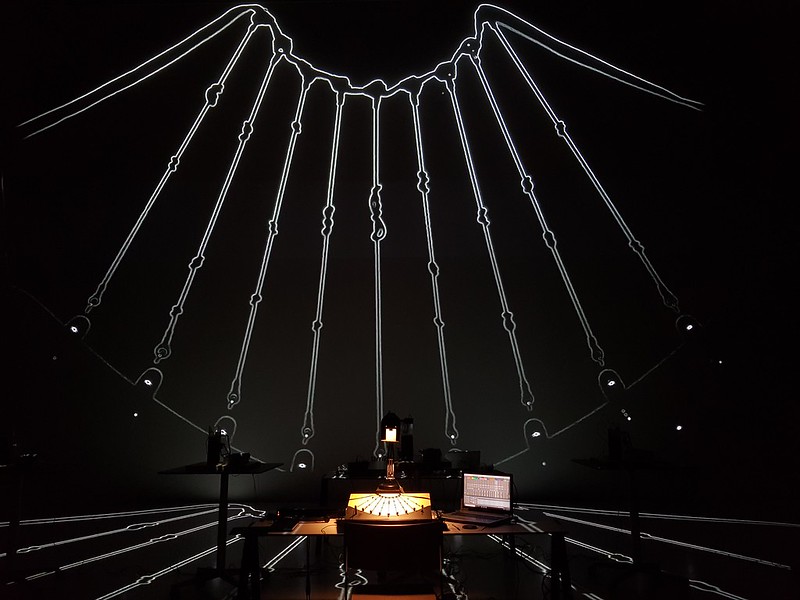_knotting the memory//Encoding the khipu_
Experimental Sound Performance
2019
Experimental Sound Performance
2019
2019
The khipu is an information processing and transmission device used mainly by the Inca empire and previous Andean societies. This tangible interface is one of the first textile computers known, consisting of a central wool or cotton cord to which other strings are attached with knots of different shapes, colors, and sizes encrypting different kinds of values and information. The system was widely used until the Spanish colonization that banned their use and destroyed a large number of these devices.
In the performance Knotting the memory//Encoding the Khipu_ is used for the first time the Electronic_Khipu_ an instrument inspired by the traditional Andean Khipus, for the interaction and generation of live experimental sound by weaving knots with conductive rubber cords, that aim to pay homage to this system, from a decolonial perspective continuing the interrupted legacy of this ancestral practice in a different experience of tangible live coding and computer music, where the artist takes the place of a contemporary *khipukamayuq* (Khipu knotter) weaving the past with the present of the indigenous and people resistance of the Andean territory with their sounds.
More info about the instrument (Electronic_Khipu_) played in the performance:
Presented at :
- IN SONORA Festival Madrid
- ADAF 2020 (Athens Digital Arts Festival)
- NIME 2020 (International Conference on New Interfaces for Musical Expression)
- Zwischen_Zeiler Live: Propelling Reality - Setzkasten Wien.
- Tresor Linz
- BestOFF 2019 - Ars electronica Center
- Ars Electronica Festival 2019
The Electronic_Khipu_ was a Finalist project in the 2021 Guthman Musical Instrument Competition
Work recognized with the honorary mention of the Pamela Z Innovation Award of NIME 2020
Research paper with extended information available here: https://www.nime.org/proceedings/2020/nime2020_paper94.pdf
Photo Credits:
Tom Mesic
Jürgen Grünwald
--------------------------------------------------------------------------------------------
Press coverage:
https://www.nytimes.com/2021/03/12/arts/music/classical-music-instruments.html
https://www.sn.at/kultur/allgemein/ars-electronica-und-ihre-vielen-gesichter-in-der-postcity-75891631
https://www.ots.at/presseaussendung/OTO_20190904_OTO0001/studierende-der-kunstuniversitaet-linz-zeigen-interaktive-medienkunst-beim-ars-electronica-festival-2019
https://www.tips.at/nachrichten/linz/kultur/479531-studierende-zeigen-interaktive-medienkunst-beim-ars-electronica-festival
https://www.kultur-online.net/inhalt/transcode
https://volksblatt.at/wie-klang-noch-mal-der-videorekorder/
https://www.dorftv.at/video/31844
https://ars.electronica.art/outofthebox/en/transcode/
https://www.ufg.at/Archivdetail.2267+M54ada77e90a.0.html?&tx_ttnews%5Bpointer%5D=1
https://www.ufg.at/Interface-Cultures-at-Ars-Electronica-20.16578+M5afd8dd29e1.0.html
https://www.ufg.at/fileadmin/media/institute/medien/abteilungen/interface_cultures/news_archiv/2019/0819_transcode.pdf
https://ars.electronica.art/outofthebox/en/knotting/
https://www.ufg.at/knotting-the-memory-encoding-the-khipu.16626+M5afd8dd29e1.0.html
http://interface.ufg.ac.at/blog/knotting-the-memory-encoding-the-khipu_/
https://www.sn.at/kultur/allgemein/ars-electronica-und-ihre-vielen-gesichter-in-der-postcity-75891631
https://www.ots.at/presseaussendung/OTO_20190904_OTO0001/studierende-der-kunstuniversitaet-linz-zeigen-interaktive-medienkunst-beim-ars-electronica-festival-2019
https://www.tips.at/nachrichten/linz/kultur/479531-studierende-zeigen-interaktive-medienkunst-beim-ars-electronica-festival
https://www.kultur-online.net/inhalt/transcode
https://volksblatt.at/wie-klang-noch-mal-der-videorekorder/
https://www.dorftv.at/video/31844
https://ars.electronica.art/outofthebox/en/transcode/
https://www.ufg.at/Archivdetail.2267+M54ada77e90a.0.html?&tx_ttnews%5Bpointer%5D=1
https://www.ufg.at/Interface-Cultures-at-Ars-Electronica-20.16578+M5afd8dd29e1.0.html
https://www.ufg.at/fileadmin/media/institute/medien/abteilungen/interface_cultures/news_archiv/2019/0819_transcode.pdf
https://ars.electronica.art/outofthebox/en/knotting/
https://www.ufg.at/knotting-the-memory-encoding-the-khipu.16626+M5afd8dd29e1.0.html
http://interface.ufg.ac.at/blog/knotting-the-memory-encoding-the-khipu_/
------------------------------------------------------------
ESP:
El khipu es un dispositivo de procesamiento y transmisión de información utilizado principalmente por el imperio incaico y las sociedades andinas precedentes. Esta interfaz tangible es una de las primeras computadoras textiles conocidas, que consiste en un cordón central de lana o algodón al que se unen otras cuerdas con nudos de diferentes formas, colores y tamaños que encriptan diferentes tipos de valores e información. El sistema fue ampliamente utilizado hasta la colonización española que prohibió su uso y destruyó un gran número de estos dispositivos.
En este proyecto el khipu se convierte en un instrumento electrónico para la interacción y generación de sonido experimental en vivo tejiendo nudos con cuerdas de goma conductora, y se utiliza en la performance "Anudando la memoria//codificando el Khipu_"que tiene como objetivo rendir homenaje a este sistema, desde una perspectiva descolonial continuando el legado interrumpido de esta práctica ancestral en una experiencia diferente de codificación tangible en vivo y música por computadora, donde la artista toma el lugar de un contemporáneo *khipukamayuq* (la que anuda el Khipu) tejiendo el pasado con el presente de la resistencia indígena y popular del territorio andino con sus sonidos.
